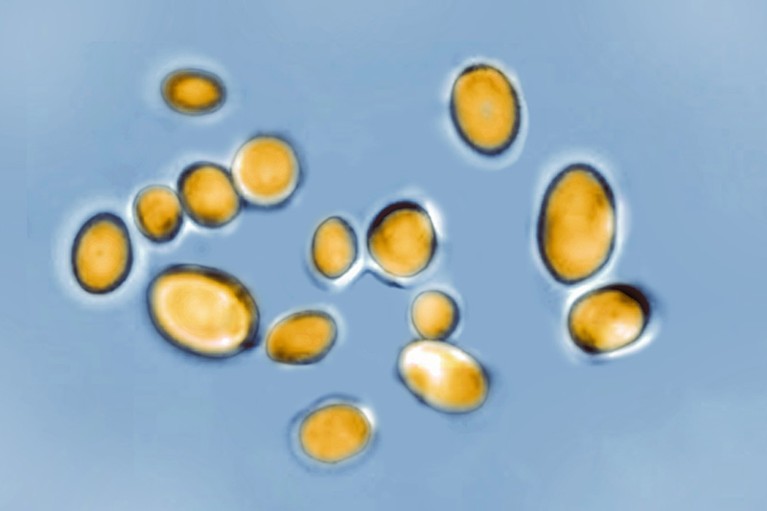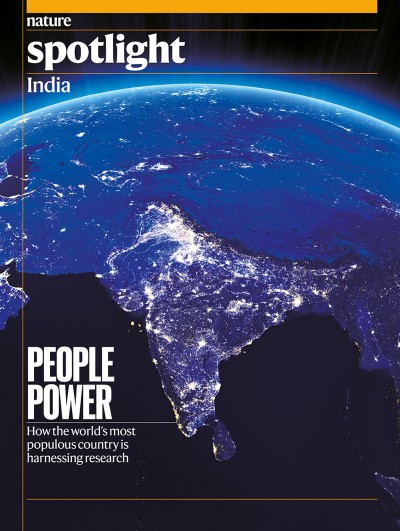
The haze that causes widespread health problems in Delhi is the focus of highly cited studies by researchers in India.Credit: Sonu Mehta/Hindustan Times/Shutterstock
India was the world’s third-most-prolific publisher of research papers in 2022, but it was ranked only 153rd for the number of citations it received per paper. Indeed, in 2020, about 30% of papers from India were not cited at all, compared with 20% in both the United States and China. These trends are mirrored in many other low- and middle-income countries whose researchers struggle to get published in high-impact journals.
But despite this challenging publishing environment, some Indian scientists have produced influential, highly cited studies in a number of fields in the past few years. Here Nature highlights several of these key areas of research that have the potential to improve public health and quality of life both domestically and globally.
Strategies to reduce air pollution
Many parts of India have highly polluted air. The University of Chicago’s Air Quality Life Index ranks India as the second-most-polluted nation in the world in terms of air quality, behind only Bangladesh, and refers to Delhi as “the most polluted city in the world”.
To improve India’s air quality, researchers must first develop a deeper understanding of the sources of this pollution and how it interacts with weather systems. Sachin Gunthe, who studies aerosols at the Indian Institute of Technology Madras, based in Chennai, has published a series of highly cited papers exploring the composition, formation and distribution of airborne pollutants. In particular, he has studied particulate matter that has a diameter of 2.5 micrometres or less (PM2.5), which can create visible haze and wreak havoc on human health, contributing to more than one million deaths a year in India alone.
In 2020, Gunthe teamed up with Narendra Ojha at the Physical Research Laboratory in Ahmedabad and his colleagues to investigate seasonal patterns of PM2.5 production and windborne distribution1. Using simulations based on meteorological data, they determined that the sources of pollution change considerably over just a few months. In October, following the monsoon season, most PM2.5 originates from burning biomass in wildfires, agriculture and household stoves, and creates pollution that spreads across northwest India to Delhi and other cities. By December, most PM2.5 arises from industrial and fossil-fuel sources in cities, where it is trapped and accumulates because of the relatively stagnant winter wind patterns. This work shows that strategies to control pollution must address seasonally changing conditions.
Gunthe then collaborated with researchers including Pengfei Liu at the Georgia Institute of Technology in Atlanta to take a deeper dive into Delhi’s air-pollution crisis. In a 2021 publication, they traced the origins of Delhi’s haze to the behaviour of a particularly small category of airborne particles measuring less than one micrometre2. They subsequently showed that in high humidity, this particulate matter interacts with ammonia and chlorine in the air, forming bigger particles that contribute to worse visibility and heightened health risk.
A follow-up study in 2022 found a feedback loop in which condensation from high water content in the air reduces the dispersal of particulate matter3. This leads to worse pollution and higher humidity, exacerbating the problem. On the basis of these results, the authors proposed a two-pronged intervention to reduce both ammonia emissions, from agriculture and fossil-fuel use, and chlorine production, which is a consequence of plastic burning and e-waste disposal in particular.
Electrodes for a hydrogen economy
One of the most exciting routes from fossil-fuel dependency is the ‘hydrogen economy’, in which energy-rich hydrogen is efficiently extracted from a cheap and abundant fuel source: water. Earlier this year, the Indian government announced its intention to build the country’s production capacity to at least 5 million tonnes of hydrogen a year by 2030, with the goal of ultimately making the country energy independent and an exporter of ‘green hydrogen’ to other major economies.
One promising strategy is to use electrochemical water-splitting systems in which two electrodes are immersed in an electrolyte solution. When voltage is applied, chemical reactions at the anode and cathode drive the production of oxygen and hydrogen gas, respectively.
Finding the best electrodes has not been straightforward, however. Most electrochemical water-splitting systems use rare and expensive metals, and lower-cost systems struggle to achieve efficient catalysis.
Several research groups in India are tackling these challenges using various alloys and routes to materials synthesis. For example, materials known as high-entropy alloys, comprising five or more elements, have attracted interest because of their stability and highly tunable catalytic performance.
In 2021, Krishanu Biswas, a materials scientist at the Indian Institute of Technology Kanpur, and his colleagues demonstrated that it was feasible to construct oxygen-generating anodes using a low-cost high-entropy alloy composed of cobalt, iron, gallium, nickel and zinc4. The anodes had excellent stability, retaining 80% of their current output after 10 hours, whereas state-of-the-art anodes based on ruthenium oxide degraded to just 30% of their initial performance in that time.
Subrata Kundu, a materials chemist at the CSIR-Central Electrochemical Research Institute in Karaikudi, is investigating the potential of another category of electrode material, based on tightly stacked layered double hydroxide (LDH) architectures. LDH materials have the advantage of being built from readily accessible and abundant elements. However, they have poor conductivity, so Kundu’s team has pursued multiple approaches to turn these substances into viable electrodes. In 2022, for example, Kundu and his colleagues developed a nickel–cobalt LDH laden with cerium and used it as both a cathode and an anode in a series of electrocatalytic water-splitting experiments5. Collectively, these efforts highlight the feasibility of greatly reducing the cost and increasing the accessibility of electrocatalytic hydrogen production in the near future.
The roots of Parkinson’s disease
It has been nearly 30 years since scientists first established the link between the abnormal aggregation of the protein α-synuclein in the brain and the neurodegenerative condition known as Parkinson’s disease. Subsequent studies have suggested that the accumulation of α-synuclein clumps and fibrils creates a toxic environment for neurons, but scientists have struggled to untangle the early events that set this process into motion.
A 2020 study from a team led by Samir Maji, a neurobiologist at the Indian Institute of Technology Bombay in Mumbai, offers a compelling model for this process6. Maji was interested in exploring a process known as liquid–liquid phase separation, in which biomolecules self-organize into compact, defined structures even in the absence of the membranes that normally form the boundaries of cellular organelles. These droplets generally retain liquid-like properties and their contents can diffuse into the surrounding environment, but proteins in the droplets also have the potential to condense into gel-like solids. Previous work indicated that such a process might have a role in the aggregation of tau proteins in the brains of people with Alzheimer’s disease7.
Maji and his colleagues coaxed α-synuclein to form analogous droplets under chemical conditions that simulate the crowded molecular environment inside cells. After the droplets formed, the proteins in them began to solidify and exhibit gel-like physical characteristics similar to the aggregates and fibrils seen in the brains of people with Parkinson’s. Similar effects could also be achieved through other triggers, including the presence of certain lipids or the use of α-synuclein variants with mutations that are known to increase the risk of Parkinson’s.
This evidence was based on experiments that used much higher concentrations of α-synuclein than are typically observed in the brain, however. Maji and his colleagues conducted a follow-up investigation in which they probed the conditions that produce this liquid–liquid phase separation and gelling process. Their report, published in 2021, showed that non-mutated α-synuclein normally remains soluble under physiological conditions8. But specific triggers, including increased protein concentration, disease-related mutation, elevated salt level, low pH and the presence of metal ions, induce this protein to condense into droplets, which subsequently solidify into neurotoxic fibrils and clumps.
The authors proposed that these conditions, which were already known to fuel α-synuclein aggregation, cause the protein to undergo a physical reorganization that exposes some unstructured sections that are normally sequestered. Once freed, these sections can interact with one another to fuel the phase-separation process, potentially setting Parkinson’s pathology into motion.
Origins of a drug-resistant yeast
Shortly before the emergence of the COVID-19 pandemic, the US Centers for Disease Control and Prevention drew attention to a different type of infectious menace: the yeast Candida auris, which the agency termed an “urgent threat” to public health in 2019. Infection with C. auris occurs mainly in hospitals, where it can cause severe and even fatal bloodstream infections. A growing number of reports indicate that existing antifungal agents might be insufficient to fend off this pathogen.

View from an optical microscope of Candida auris, which causes drug-resistant infections.Credit: BSIP/Education Images/Universal Images Group via Getty
The scale of the problem remains poorly understood because of a lack of data. Among the researchers working to fill this void is Anuradha Chowdhary, a medical mycologist at the University of Delhi, who has published a series of studies evaluating the prevalence of drug-resistant C. auris in India. In a highly cited publication from 2018, she led a multinational effort to screen hundreds of isolates from fungal infections collected at ten Indian hospitals over the previous eight years9. The vast majority were resistant to fluconazole, a standard front-line treatment for severe fungal infections, and one-quarter of the isolates exhibited resistance to several antifungal drugs.
In a follow-up study in 2020, Chowdhary’s team examined how the rising prevalence of these drug-resistant hospital-based infections affected patient outcomes in the early days of the COVID-19 pandemic10. They observed ten cases of C. auris infection in a cohort of 596 patients at a single New Delhi hospital and found that it was generally acquired in the hospital from exposure to contaminated instruments such as catheters and respirator tubes. Once again, all the isolates were resistant to fluconazole, and an alarming 70% exhibited multidrug resistance, with three isolates showing broad resistance to three different categories of antifungal drug.
These studies highlighted the risk this pathogen poses, but its origins remain shrouded in mystery. The first clinical isolates were reported as recently as 2009, in hospitals in South Korea and Japan. Chowdhary’s group has investigated how and where C. auris might have spilled over from the natural environment into human hosts. They uncovered isolates of this fungus that are closely related to clinically observed, pathogenic C. auris strains from wetlands in the Andaman Islands in the Bay of Bengal, as well as in domestically grown fruit sold in and around Delhi. Based on the latter observation, the authors raise the disconcerting possibility that routine fungicide treatment of orchards could be creating a selective pressure that drives the resistance to therapeutic drugs in this yeast species.


 India’s year in science
India’s year in science
 Where science meets Indian economics: in five charts
Where science meets Indian economics: in five charts
 Renewable energy for the subcontinent
Renewable energy for the subcontinent
 We need to talk about water
We need to talk about water
 The climate disaster strikes: what the data say
The climate disaster strikes: what the data say
 I predict solar storms
I predict solar storms
 The fight against antimicrobial resistance
The fight against antimicrobial resistance
 India struggles to turn science into societal benefits
India struggles to turn science into societal benefits
 Big ideas: India’s drive to stem the brain drain
Big ideas: India’s drive to stem the brain drain
 I study depression in the lab and advocate for mental health in academia
I study depression in the lab and advocate for mental health in academia






